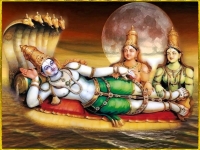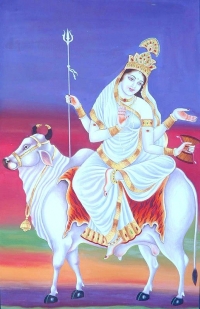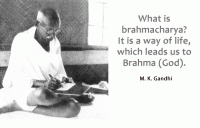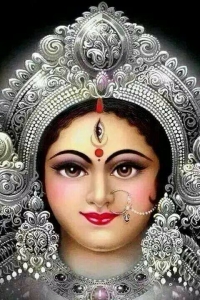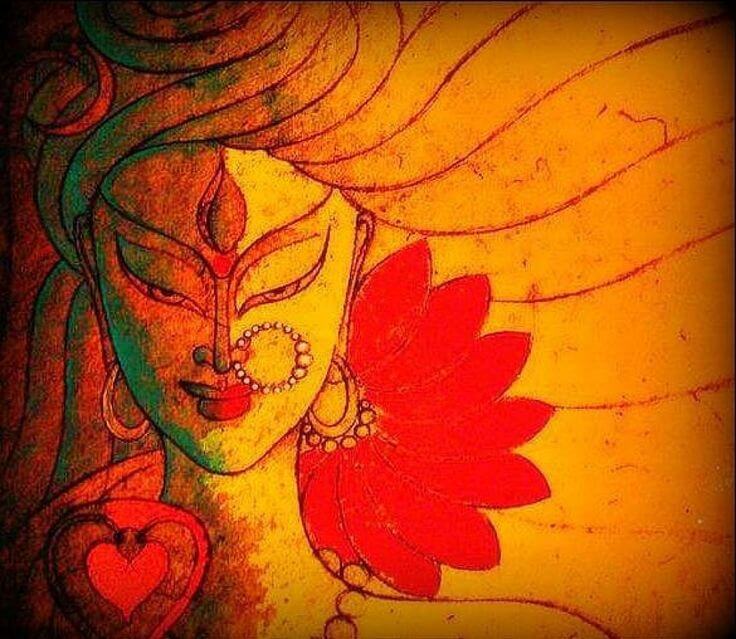
Parvati is the Hindu goddess of fertility, love and devotion; as well as of divine strength and power. Known by many other names, she is the gentle and nurturing aspect of the Hindu goddess Shakti and one of the central deities of the Goddess-oriented Shakta sect. She is the mother goddess in Hinduism, and has many attributes and aspects. Each of her aspects is expressed with a different name, giving her over 100 names in regional Hindu stories of India. Along with Lakshmi (goddess of wealth and prosperity) and Saraswati (goddess of knowledge and learning), she forms the trinity of Hindu goddesses (Tridevi).
Parvati is the wife of the Hindu god shiva - the protector, the destroyer (of evil) and regenerator of universe and all life. She is the daughter of the mountain king Himavan and queen Mena. Parvati is the mother of Hindu deities Ganesha and Kartikeya. The Puranas also referenced her to be the sister of the god Lord Vishnu and the river-goddess Ganga.
Story of How Parvati Was Born
When Sati Devi left her body, shiva became an ascetic. He just spent all His time in meditation. And at that time a great asura named Tarakasura, the illuminator of duality, did tremendous austerities and Brahma came to him and said, “What do you want?” He said, “I want to be immortal.”
Brahma said, “That’s impossible, no one is immortal, whatever comes in to manifestation must go out of manifestation, Srishti Sthiti Laya, there is a cyclical transformation of energy. Nothing is permanent, choose another boon.”
So Tarakasura, this illuminator of duality, he said, “If my death has to occur, I want to be slain only by the son of shiva.” Brahma said, “Why would you want a boon like that?” And Tarakasura said, “Well shiva doesn’t have a wife, and he spends all his time in meditation, and it doesn’t look like he’s going to have an opportunity to get a wife. And if he doesn’t have a wife, what question is there of his having a son, so therefore I will become immortal.”
.jpg)
And Brahma said, “Tatastu, I give you the boon, immediately, without hesitation.”
And Tarakasura became the ruler of the three worlds, he conquered the entire earth, made everyone on the earth a servant of the illuminator of duality. He marched up to heaven, and he threw all the Gods out of heaven. And the Gods were extremely depressed, “We lost our divinity and now we have to wander around the earth like human beings, yeck, that’s awful.”
So then the Gods devised a plan, we’ve got to find a way to make Sati Devi come back in to her body. And they all went to the Himalayas, actually they really went to the Devi Mandir. They went to the Devi Mandir and they began to chant, and they began to practice meditation, and perform austerities, and they enkindled the Divine Fire, and they started a Yagya. And they all sat around the Yagya Fire and they chanted the mantras and made offerings.
And finally the Divine Mother was pleased. And she said, “What do you want?” And the Gods said, we all said, “Hey Mom, shiva is sitting there like there is no tomorrow, all He does is meditate. He has no responsibility whatsoever. And He will not get motivated until you come back into your body. So we’re going to request you, please Maa, manifest in a form and marry shiva. And give us the son that’s going to lead the armies of the Devas to victory. Only the son of shiva can conquer Tarakasura.”
Maa said, “Tatastu, I give you the boon. And I will come into a body in the home of Himalaya, because Himalaya has been worshipping me with one pointed attention, in fact He doesn’t move. There is no one as steady and as solid as the Himalayas. He just sits there making japa, yuga after yuga after yuga. I’m going to become Shailaputri, the daughter of the mountain, the Goddess of inspiration. And I will perform tapasya, and if shiva will have me, I’ll marry shiva.”
And the Gods were filled with extreme joy. And then they waited for the birth of Parvati, the daughter of the Parvat.
Symbolism
There are many different styles of picture of Parvati. Often she can be seen as the family woman, with shiva at her side and young Ganesha in her lap.
Other times she is in the form of Durga: dressed in red, riding a lion, her arms full of weapons. The red represents purity and powerful destruction of evil. The weapons destroy ignorance, evil, and ego.
At times she is shown carrying the trishula trident, same as shiva. Its three prongs are said to represent the three gunas/qualities: tamas, rajas, and satwa.
“Fertility, marital felicity, devotion to the spouse, asceticism and power are different virtues symbolized by Parvati.” –
Manifestations and aspects of Parvati
everal Hindu stories present alternate aspects of Parvati, such as the ferocious, violent aspect as Shakti and related forms. Shakti is pure energy, untamed, unchecked and chaotic. Her wrath crystallizes into a dark, blood-thirsty, tangled-hair Goddess with an open mouth and a drooping tongue. This goddess is usually identified as the terrible Mahakali or Kali (time). In Linga Purana, Parvati metamorphoses into Kali, on the request of shiva, to destroy a female asura (demoness) Daruka. Even after destroying the demoness, Kali's wrath could not be controlled. To lower Kali's rage, shiva appeared as a crying baby. The cries of the baby raised the maternal instinct of Kali who resorts back to her benign form as Parvati.
In Skanda Purana, Parvati assumes the form of a warrior-goddess and defeats a demon called Durg who assumes the form of a buffalo. In this aspect, she is known by the name Durga. Although Parvati is considered another aspect of Sakti, just like Kali, Durga, Kamakshi, Meenakshi, Gauri and many others in modern-day Hinduism, many of these "forms" or aspects originated from regional legends and traditions, and the distinctions from Parvati are pertinent
Major Temples

Parvati is often present with shiva in Saivite Hindu temples all over South Asia and southeast Asia.
Some locations (Pithas or Shaktipeeths) are considered special because of their historical importance and legends about their origins in the ancient texts of Hinduism. Other locations celebrate major events in Parvati's life. For example, the World Heritage Site at Khajuraho is one such site where Parvati temple is found. It is one of the four major sites associated with Parvati, along with Kedarnath, Kashi and Gaya. The temple’s origin in Khajuraho has been traced to the Hindu mythology in which Khajuraho is the place where Parvati and shiva got married.

